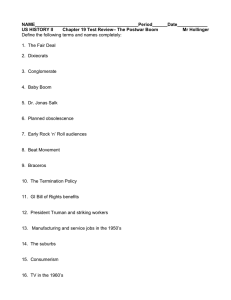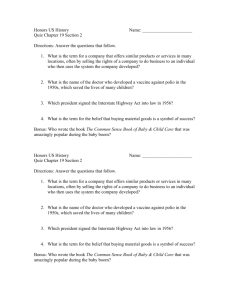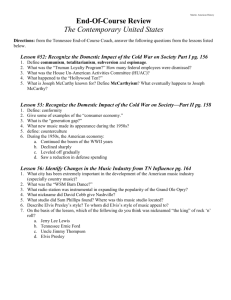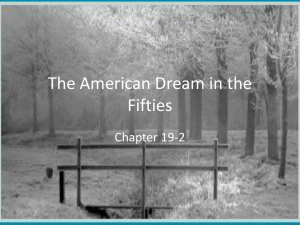1950s Society Video Cultural Overview
advertisement
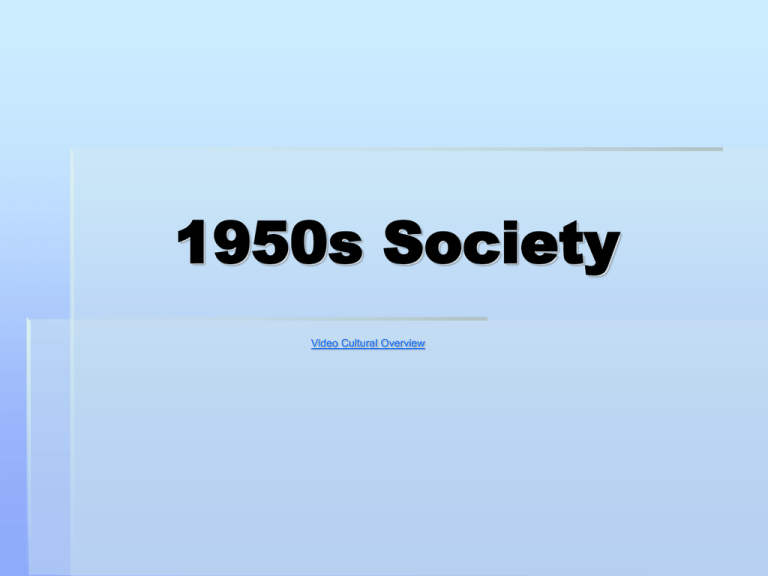
1950s Society Video Cultural Overview Economics after WW2 1950-1970 long economic boom National income doubles in 1950s and again in 1960s Middle Class doubles to 60% of pop’n Own cars, TVs, washing machines Agribusiness – mechanized farming More workers shift to industry/white collar “Affluent Society” Luckiest Generation Causes Economics after WW2 Economy recovers – why? Cheap energy – low cost of petroleum Productivity cold war spending, marshall plan GI Bill of 1944 15 million returning veterans Encouraged veterans to get an education Unemployment benefits Loans for homes, farms, businesses 1956 Interstate Highway Act largest public works project in American history! Cost $32 billion. 41,000 miles of new highways built. Baby Boom Baby Boom It seems to me that every other young housewife I see is pregnant. -- British visitor to America, 1958 1957 1 baby born every 7 seconds Effects Suburbia By 1960, 25% of Americans live in suburbs FHA/VA low interest loans Tax deductions for mortgage payers Suburban Living The American Dream 1949 William Levitt built 150 houses/week. Standardized plans, factory assembled frames Consumerism Consumerism What do you notice? Washer Machine Coffee TV Well-Defined Gender Roles The ideal modern woman married, cooked and cared for her family, and kept herself busy by joining the local PTA and leading a troop of Campfire Girls. She entertained guests in her family’s suburban house and worked out on the trampoline to keep her size 12 figure. -- Life magazine, 1956 The ideal 1950s man was the provider, protector, and the boss of the house. -- Life magazine, 1955 Teen Culture From Frank Sinatra to Elvis Presley Result = Generation Gap Elvis on Ed Sullivan, Sept 1956 vs. Elvis on Ed Sullivan, Oct 1956 Reasons for Generation Gap? Example1 vs. Example2 Rock ‘n’ Roll based on African American rhythm and blues music of the 1930s and 1940s Chuck Berry Examples of Generation Gap 1953: six counties in South Carolina outlawed any jukebox in hearing distance of a church. 1954: “Good Rockin’ Tonight” by Elvis was deemed objectionable by the Juvenile Delinquency and Crime Commission in Houston. They wanted it banned from the radio and record stores.* 1955: CBS cancelled “Rock-n-Roll Dance Party” after they showed a black singer dancing with a white girl. 1956: San Antonio, TX removed all rock-n-roll from jukeboxes by swimming pools. Unintended Impacts of Prosperity? Conformity Reactions: Group of writers and artists, called the beats or beatniks, criticized American culture for being stale and empty Little Boxes Poverty Amid Prosperity Poverty rate nearly double today’s As middle class families moved to the suburbs, cities lost important tax dollars “White Flight” Patterns of racial discrimination left many minorities in poverty Racial Tensions Heighten Despite 15th Amendment: Literacy tests Poll taxes Voter registration included address, employer, list of family members Brown v. Board of Education 1954 Supreme Court case determined segregation in public schools was unconstitutional Crisis in Little Rock Crisis in Little Rock https://www.youtube.com/watch?v=CAPOvdOEYE8 Arkansas governor used National Guard soldiers to block 9 African American students from entering a high school. When the president told the governor to remove the soldiers, an angry mob of white citizens prevented the students from entering Finally, President Eisenhower had to send U.S. soldiers to Arkansas to force integration and following of law.

